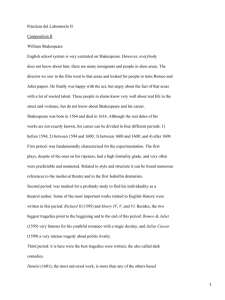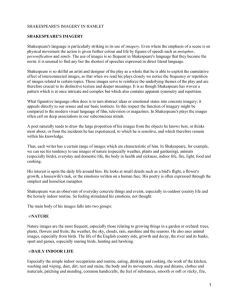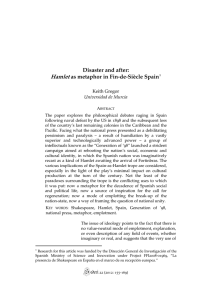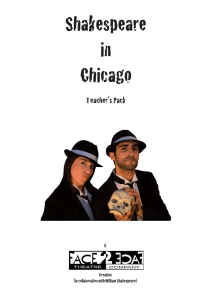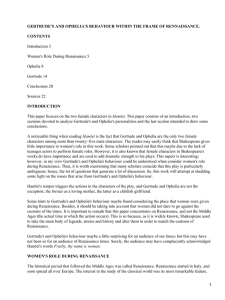hamlet: the advent of modernity - Revistas Científicas de la
Anuncio
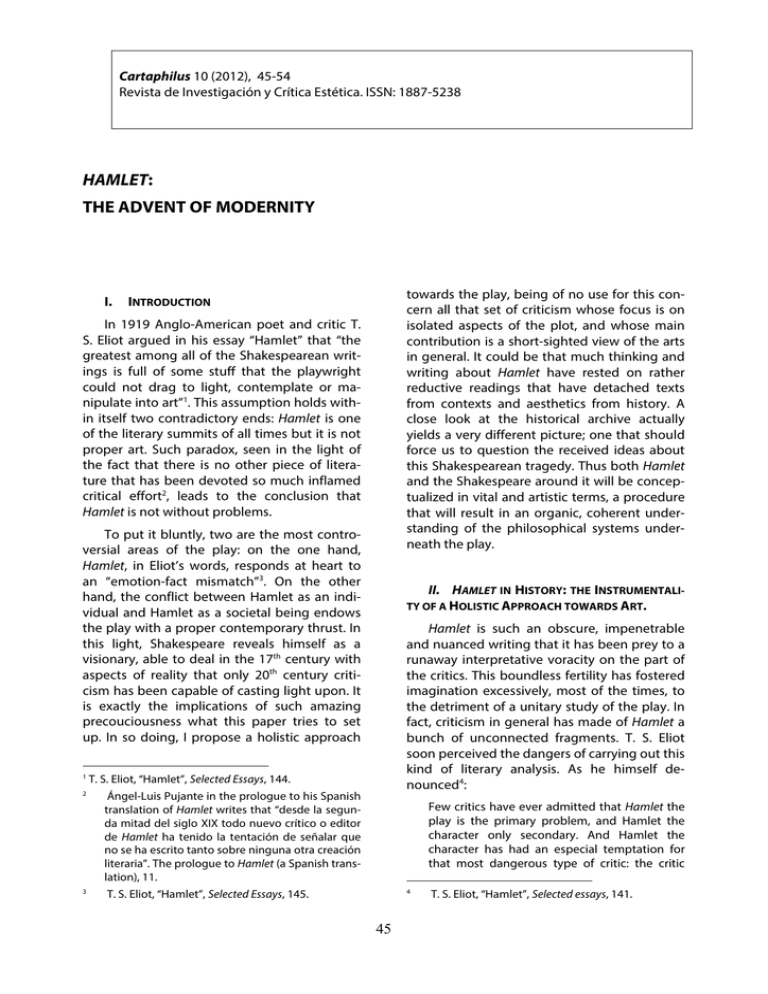
Cartaphilus 10 (2012), 45-54 Revista de Investigación y Crítica Estética. ISSN: 1887-5238 HAMLET: THE ADVENT OF MODERNITY I. towards the play, being of no use for this concern all that set of criticism whose focus is on isolated aspects of the plot, and whose main contribution is a short-sighted view of the arts in general. It could be that much thinking and writing about Hamlet have rested on rather reductive readings that have detached texts from contexts and aesthetics from history. A close look at the historical archive actually yields a very different picture; one that should force us to question the received ideas about this Shakespearean tragedy. Thus both Hamlet and the Shakespeare around it will be conceptualized in vital and artistic terms, a procedure that will result in an organic, coherent understanding of the philosophical systems underneath the play. INTRODUCTION In 1919 Anglo-American poet and critic T. S. Eliot argued in his essay “Hamlet” that “the greatest among all of the Shakespearean writings is full of some stuff that the playwright could not drag to light, contemplate or manipulate into art”1. This assumption holds within itself two contradictory ends: Hamlet is one of the literary summits of all times but it is not proper art. Such paradox, seen in the light of the fact that there is no other piece of literature that has been devoted so much inflamed critical effort2, leads to the conclusion that Hamlet is not without problems. To put it bluntly, two are the most controversial areas of the play: on the one hand, Hamlet, in Eliot’s words, responds at heart to an “emotion-fact mismatch”3. On the other hand, the conflict between Hamlet as an individual and Hamlet as a societal being endows the play with a proper contemporary thrust. In this light, Shakespeare reveals himself as a visionary, able to deal in the 17th century with aspects of reality that only 20th century criticism has been capable of casting light upon. It is exactly the implications of such amazing precouciousness what this paper tries to set up. In so doing, I propose a holistic approach 1 2 3 II. HAMLET IN HISTORY: THE INSTRUMENTALITY OF A HOLISTIC APPROACH TOWARDS ART. Hamlet is such an obscure, impenetrable and nuanced writing that it has been prey to a runaway interpretative voracity on the part of the critics. This boundless fertility has fostered imagination excessively, most of the times, to the detriment of a unitary study of the play. In fact, criticism in general has made of Hamlet a bunch of unconnected fragments. T. S. Eliot soon perceived the dangers of carrying out this kind of literary analysis. As he himself denounced4: T. S. Eliot, “Hamlet”, Selected Essays, 144. Ángel-Luis Pujante in the prologue to his Spanish translation of Hamlet writes that “desde la segunda mitad del siglo XIX todo nuevo crítico o editor de Hamlet ha tenido la tentación de señalar que no se ha escrito tanto sobre ninguna otra creación literaria”. The prologue to Hamlet (a Spanish translation), 11. Few critics have ever admitted that Hamlet the play is the primary problem, and Hamlet the character only secondary. And Hamlet the character has had an especial temptation for that most dangerous type of critic: the critic 4 T. S. Eliot, “Hamlet”, Selected Essays, 145. 45 T. S. Eliot, “Hamlet”, Selected essays, 141. HAMLET: THE ADVENT OF MODERNITY with a mind which is naturally of the creative order, but which through some weakness in creative power exercises itself in criticism instead. gan, “the spell of literary theory, an umbrella term for criticism featuring the ideas of Jacques Derrida, Jacques Lacan and Michel Foucault among many others”9. These new tendencies are characterized by their looseness of argument, which has led to his assumption that “Hamlet is now a play object for contemporary critics”10. No doubt, the critic refers here to all the corpus of criticism around Hamlet produced in the Romantic period, with Goethe and Coleridge as its leading figures. From this assumption two main questions arise: has Hamlet criticism always been like this? and, from which parameters should the play be approached? A brief walk through the critical panorama written on the play will answer these two mysteries. In the light of such mistaken criticism, Kerrigan proposes an approach to Hamlet at the crossroads of literary formalism, historical scholarship and intellectual history. His procedure is aimed, on the one hand, at fighting back the above-mentioned kinds of criticism that “rejected the old motives of displaying a work of art’s emotional and intellectual force and made no effort to achieve a coherent understanding of the entire play”. On the other hand, he also focuses attention on the abandoned tradition of Hamlet commentary, which might still inspire fruitful approaches to the play. William Kerrigan’s work “Hamlet in History”5 goes through the main approaches used to conceptualize the play from the Romantic era— where this piece of writing reached the high status it has nowadays in the “Olympus” of the literary creation—to the most updated tendencies, those of the postmodern theorists. From Kerrigan’s perspective, the former end, the romantic one—in tune with Eliot’s belief—, is mostly a “woeful example of chaotic impressionism based on vesting imaginative creations with the extratextual life of the critic”6. In fact, it is very easy to fall into this kind of subjective criticism, being the transmission of ideologies rather than ideas its most problematic aspect: “[uno de los riesgos de la lectura de Hamlet] es proyectarse en ella, ocuparla con nuestras inquietudes, obsesiones o ideas preconcebidas y desahuciar buena parte de sus realidades”7, Ángel-Luis Pujante8 remarks. Although Kerrigan does not allude to this fact—he just mentions the Anglo-American fleetingly—, Eliot was the first critic who saw the convenience of recovering for his present the main premises of 17th and 18th century criticism on Hamlet. As he himself wrote11: Critics of the seventeenth and eighteenth centuries were nearer in spirit to Shakespeare art; and as they insisted on the importance of the effect or the whole rather than on the importance of the leading character, they were nearer, in their old-fashioned way, to the secret of dramatic art in general. At the other extreme of this interpretative spectrum, we find, to borrow again from Kerri5 “Hamlet in History” is the first chapter of Kerrigan’s book Hamlet’s Perfection, 1-33. 6 William Kerrigan, “Hamlet in History”, Hamlet’s Perfection, 2. 7 “When reading Hamlet, one takes the risk of projecting oneself into the play, of invading it with our uneasiness, obsessions or preconceived ideas, neglecting so a great deal of its implications”. 8 This is exactly the kind of approach I will be using hence in order to flesh out the claims I made at the beginning of my essay with regard to both Hamlet’s inadequacy between deeds and the emotion they should convey and Ham- Ángel-Luis Pujante, the prologue to Hamlet (a Spanish translation), 12. 46 9 William Kerrigan, “Hamlet in History”, Hamlet’s Perfection, 3. 10 William Kerrigan, “Hamlet in History”, Hamlet’s Perfection, 4. 11 T. S. Eliot quotes Professor Stoll of the University of Minnesota, “Hamlet”, Selected Essays, 141-42. HAMLET: THE ADVENT OF MODERNITY let’s modernity. In so doing, I will be proposing an all-embracing kind of criticism in the light of which all the fragments, all the components, shaping a work of art would organize themselves in a way that they would constitute a harmonic whole. Actually, if Hamlet was conceived as one, why should the critics reduce it to a “play object” madly run by their imagination? tions—as it happened with most of Shakespeare’s production but Hamlet13 and the Metaphysical Poets—are worth considering as a model for the literary ideal Eliot bears in mind. In this light, Shakespeare is one of the best examples of this comprehensive approach to the world of art Eliot proposes. And yet, Hamlet does not achieve to generate a sound ‘objective correlative’14, because in the culminating moments of the play, unlike in the rest of his other tragedies, feelings or emotions are not conveyed through tangible images shaped by textual material15. Why so?: Hamlet is way too psychological and, then, what he feels cannot be easily pinned down with words. III. ELIOT AND THE OBJECTIVE CORRELATIVES: DEFINING THE “HAMLET” PROBLEM. It is quite obvious that underlying Eliot’s conception of how art should be looked at, there is a particular way of conceiving life, of approaching reality. According to the AngloAmerican critic “the only way of conveying emotion in the form of art is by finding an ‘objective correlative’; in other words, a set of objects, a situation, a chain of events which shall be the formula of that particular emotion”12. From this assumption it is possible to infer that proper literature for him can only happen when through external facts, which must end up being sensory experience, an emotion is immediately evoked. And this is exactly what Hamlet lacks. This ‘airiness’ does not need to go to the detriment of its dramatic running, but it is undeniable that, through its many soliloquies, the play acquires a quite mental, weird imprint. “Habría que preguntarse”, as Ángel-Luis Pujante does, “si buena parte de su interés dramático no reside en todo lo que tiene [Hamlet] de misterio, enigma o indefinición”16. That is, Eliot, through his ‘objective correlatives’, attacks frontally the fragmented nature of contemporary reality. Eliot’s major poem, The Waste Land, denounces the dissociated character of modern sensibility as conceived after Descartes. According to the Anglo-American artist, the French philosopher had signaled to excess the importance of a rational, objective approach towards life, which went to the detriment of emotions. So, Western societies, by following Descartes’ principles, had become dehumanized territories where there was no room either for subjectivity or its main product; literature. In his view, it is by gathering words together artistically that a unified sensibility can be achieved. But not all kind of literature is useful. On the contrary, just those pieces of writing that bring together reason and emo12 T. S. Eliot, “Hamlet”, Selected Essays, 145. 47 13 King Lear could also be said to lack a sound objective correlative. For further information see “King Lear as Metaphor”, Hamlet and Other Shakespearean Essays. 14 This point could also be made with regard to King Lear. In fact, both tragedies are considered to be his most psychological productions and, at the same time, they compete as well to be Shakespeare’s greatest writing. For further information with regard to this last point, see Ángel-Luis Pujante’s Hamlet (a Spanish translation), 14. 15 Eliot argues that “if you examine any of Shakespeare more successful tragedies, you will find this exact equivalence; you will find that the state of mind of Lady Macbeth walking in her sleep has been communicated by you by a skilful accumulation of imagined sensory impressions; the words of Macbeth on hearing of his wife’s death strike us as if, given the sequence of events, these words were automatically released by the last event in the series”. In his view, it is a lack of adequacy between facts and emotion what is deficient in Hamlet: the magnitude of what the hero wants to express does not correlate with the textual material Shakespeare chose to communicate them. 16 “We should question whether or not a great deal of the dramatic interest of the play does not lie in what Hamlet has of mystery, riddle or vagueness”. HAMLET: THE ADVENT OF MODERNITY the problem of the relation of ‘knowledge’ to the knower, to what a man is, to the true or distorted imagination. Shakespeare would be setting up the basis of a new kind of theatre not aimed at drawing perfectly limited conclusions. On the contrary, Hamlet would be devoted to exploring mysterious aspects of the human psyche rather than to transmitting some kind of truth / knowledge about ‘us’. Giving his increasingly interest in human psychology, he tries hard to determine which the last consequences of this worn out maniquean dilemma “to be or not to be” are. Thus it is legible to place the blame of the absence of clarity of Hamlet on the magnitude of the ‘riddle’ to sort out. That is the reason why if the essential emotion of the play were the feeling of a son towards a guilty mother, Shakespeare would not have had problems to expand this subject-matter into a coherent, self-complete tragedy just as he did in Macbeth, Othello or Coriolanus. But Hamlet is much more than a treatise on damnation, jealousy or excessive pride. The tragedy tries to reveal the essences of our existence, a knowledge that, paradoxically enough, is beyond our understanding. In this sense, Hamlet tension stems from the opposition between what we are and what we would like to be. So Hamlet himself says to his mother: “seems, madam! Nay, it is; I know not seems” [I.ii]. The tragic hero want to “be” in a world of mistaken cadences where everybody has assumed the deceitful nature of the human condition. Take the following speeches— among many others—as illustrative examples of this claim: Horatio refers to the ghost of Hamlet’s father as “Before my God, I might not this believe / Without the sensible and true avouch / of mine own eyes”[I.i]. Hamlet also illustrates this fact when he speaks of the theatre actors: Thus, if Hamlet, as compared to the Shakespearean tragedy canon, is not quite the ticket after all, one wonders what might be. As one pursues to anchor down the reasons for Hamlet’s bafflement and, by extension, that unattainable, blurring feeling that permeates throughout the play, it is necessary to make it clear whether or not Hamlet’s uneasiness can be paralleled to an artist, Shakespeare in this case, unable to complete his own enterprise. In so doing, it is a must to take a close look at those two forces constituting the core of Hamlet: myth and psychology. III.I Hamlet: the Rise of Psychology The reason why Hamlet lacks a strong ‘objective correlative’ is to be found in the psychological depth the play unfolds. It is not that the rest of Shakespeare’s literary production is devoid of psychological insight but never before had the English playwright gone so deep into human mental processing. Up to that point in time when he started pursuing Hamlet, he had dealt with the psychological implications of isolated behavioral aspects of mankind. However, with Hamlet, Shakespeare tries to map out the meaning of men’s existence, that is, the psychological implications of ‘being’ as human as a whole rather than a single aspect of it. As L. C. Knights17 remarks: O, what a rogue and a peasant slave am I! Is it not monstrous that this player here, But in a fiction, in a dream of passion, Could force his soul so to his own conceit That from her working all his visage wann’d; Tears in his eyes, distractions in’s aspect, A broken voice, and his whole functioning suiting With forms to his conceit? And all for nothing! [II.ii] Hamlet belongs to the year 1600 or to the early months of 1601. It thus comes near the beginning of a period when Shakespeare was much concerned with the relationships between the mind, the whole reflective personality, and the world with which it engages... [Hamlet] raises Ángel-Luis Pujante, the prologue to Hamlet (a Spanish translation), 13. 17 Ophelia also criticizes this appearancereality problem when she defends before her L.C. Knights, “An Approach to Hamlet”, Hamlet and Other Shakesperean Essays, p. 2 48 HAMLET: THE ADVENT OF MODERNITY brother, Laertes, the treatment the prince dispenses her: sible then to set a bridge of coherence, an ‘objective correlative’, in a world, our mind, that does not respond to a logical functioning. Thus Shakespeare reveals himself as a well knower of human individuals as we started to be understood after the rise of Freudian psychology at the end of the 19th century: Hamlet, like we all, lacks a stable personality, which leads to the fact that his identity is often multiple, fragmentary and contradictory. I shall the effect of this good lesson keep As watchman to my heart. But good my brother, Do not, as some gracious pastors do, Show me the steep and thorny way to heaven, Whiles, like a puff’d and reckless libertine, Himself the primrose path of dalliance treads In this light, it could be that Eliot disregarded Hamlet because, in the end, the play does not offer answers on the mysteries of humanity. It just reveals frustration at its ease. And never could Eliot have considered this lack of hope, this collection of fragmentary inner thoughts, as art. We only have to recall the last line of The Waste Land—Shantih shantih shantih or the Peace which passeth understanding— in close relation to his above-mentioned conception of literature to check that Eliot’s poetics and what Hamlet tells are opposite ends. Did Hamlet understand anything? Not at all. But everything points out to the fact that Shakespeare on purpose suspended his hero on that existential void to signal the burden of “being”. At any rate, however much distant the tragedy is from Eliot’s ideals, the AngloAmerican is not entitled to deform Hamlet with his view of what art is. And recks not his own rede. [I.iii] In this light, the play appears as a terrain where individuals are both unknowable to themselves and to those surrounding them. Actually, Hamlet’s weariness is about “the unbearable lightness of being”18, which supports Eliot’s assumption that “Hamlet is up against the difficulty that his disgust is occasioned by his mother, but that his mother is not an adequate equivalent for it; his disgust envelops and exceeds her”19. Eventually, the hero is reluctant to accept both the foul state of the human condition in general and, in particular, the fact that “something is rotten in the state of Denmark” [I.iv]: “it is not very strange; for my uncle is king of Denmark, and those that would make mows at him while my father lived give him twenty, forty, fifty, a hundred ducats apiece for his picture in little. ‘Sblood’, there is something in this more than natural, if philosophy could find it out” [II.ii]. III.II Hamlet: in Quest for the Mythical Substratum of Modernity. It is true that T. S. Eliot perceived the enigmatic nature of the play very well contributing so to the better understanding of the play. However, Hamlet cannot be considered “an artistic failure” because of “the lack of adequacy of the emotion to the external”: The Tragedy of the Prince of Denmark is about existential problems, about psychological fury before the uselessness of trying to understand what we are and the means in which we live. It is impos18 19 Apart from providing some kind of psychological insight in his works, the Elizabethan playwright was very fond of archetypes. One just needs to take a close look at his plays: there are myths everywhere. Through them, Shakespeare carries out in a cathartic fashion a wide exploration of human behavioral recurring patterns. In the case of Hamlet, and, due to its psychological introspection, it is not easy to define which archetypal maxims, if any, work there. Intuitively, we all have a culturally constructed preconception of what a myth is. However, if we are asked to provide a defini- The Unbearable Lightness of Being is the title of a vook by Czech writer Milan Kundera. T. S. Eliot, “Hamlet”, Selected Essays, p. 144. 49 HAMLET: THE ADVENT OF MODERNITY tion, the probability that we find ourselves at a loss is very high. Perhaps we could draw the conclusion, as Robert Graves20 does, that a myth is “an hereditary story more often than not containing supernatural beings and which answer simple but fundamental questions about human existence such as who made the world?, how will it end?, who was the first person? or where do souls go after death?” Needless to say, Hamlet shares in all these aspects. But, once again, it is much more: the mythical substratum at play there aims to justify an emerging conception of the world, a modern world that cannot be conceptualized around the premises of the old times. As Angél- Luis Pujante remarks “Hamlet no es sólo gran literatura, sino uno de los grandes mitos de occidente”. A myth that embodies the “expresión artística del hombre moderno, complejo y escéptico, ilusionado y desilusionado con los ideales humanísticos”. swer to the sufferings people were bound to endure while alive was always to be found in the realms of heaven or hell. That is to say, the meaning of one’s life was not to be found inside the individual but in a metaphysical, intangible truth through which human beings could fill with semantic content. Hamlet, on the contrary, portrays a hero who dives for essentials in his own interior and in others’ deeds. Taking Hamlet as a reference point, let us now define which the main features of this new kind of individual prey to a modern drive are in opposition to the universe traditional mythologies used to recreate. Rivers of ink has been written with regard to Hamlet’s modernity. They range from what the Schlegel brothers’ assumption that “the central fact of a character shaped about a delay in action permitted Hamlet to mark the difference between classical and modern”21 to Bradley’s explanation that “ancient tragedy was based on moral conflict, whereas Hamlet [as an image of modern tragedy] is personal, concentrating our interest on individuality as such”22. Of course this is true of the play but, in my view, its instrumentality lies in the nature of the hero. Hamlet reverts the paradigm of classical-tragedy heroes as Northrop Frye portrayed them in The Anatomy of Criticism23. According to him, In Shakespeare’s conception of what a modern individual is, psychology plays a crucial role in so far ‘being’ consciously can only be approached from the inside of a mind. However, the conclusion to draw is rather gloomy: much with regard to us is unknowable, human beings are not complete entities but fragments of dust. In this sense, Hamlet is doubly defeated by the collapse of both Humanism and Christianity. At any rate, the tragic hero, in the absence of divine justice, explores, at least, his interior in the search for an answer to what is eating him up—“The time is out of joint. O cursed spite, / That ever was I born to set it right”. if [the main character is] superior in degree to other men but not to his natural environment, the hero is a leader. He has authority, passions, and powers of expressions far greater than ours, but what he does is subject both to social criticism and the order of nature. He is the hero of the high mimetic mode, of epic and tragedy, and it is primarily the kind of hero that Aristotle had in mind. In this sense, Hamlet does not work like one of those old myths in which a more or less allegorical pattern of motives, always exterior to our reality as humans, help us to justify the bulk of our burden: “the whips and scorns of time, / Th’ oppressor’s wrong, the proud man’s contumely, / the pangs of despis’d love, the law’s delay disease, ... [III.i]. In classical mythologies, like the Christian or the Greek, the an20 Normally proper tragic heroes act as “sacrificial scapegoat”. That is, they, with whom the welfare of the tribe or nation is identified, must For further information see Keith Gregor and David Walton’s Critical Approaches to Literature in English: a Practical Guide, p. 76. 21 William Kerrigan, Hamlet’s Perfection, pp. 6-10. 22 William Kerrigan, Hamlet’s Perfection, p. 32. 23 50 Northrop Frye, The Anatomy of Criticism, first chapter. HAMLET: THE ADVENT OF MODERNITY die to atone for the people’s sins and restore the land to fruitfulness. ty”. All of my discussion has been developed within the limits of the universe created by the play. However, it is a must to attend to the socio-historical panorama of the period when Hamlet was written to truly understand the main points at work of the play. In so doing, in the process of the world becoming literature and vice-versa, Northrop Frye’s notion of narrative rhythm26 or synchronization is of the utmost importance. Synchronization is like a thermometer that records in a piece of writing the fluctuations of a given environment. So different narrative rhythms respond to different social impulses. Which were then those impulses underneath the play? Hamlet stands up as a reaction against the most important socio-cultural landmark ever in the rise of mankind as a category prone to selfdeterminism: Renaissance humanism. Before that, and during fourteen centuries, human life had gone round the orbit of Christendom and its mistrust in that species of ours. At first sight, it could be said that the above-referred characterization of the tragic classical hero suits Hamlet. But if we take a closer look we discover how fruitless the hero’s death is: not only does he die in the everlasting process of taking revenge on his uncle, a useless fact for the welfare of his community but also the rest of his deeds cannot be considered as being laudable, especially his behavior with Ophelia. Besides, his death leaves Denmark in the hands of Fortinbras, a former enemy who, on top of that, pops in there by chance. Thus it is quite clear that Hamlet is irony rather than tragedy. That is the reason why on approaching it we get the impression of looking down on a sense of bondage, frustration, and absurdity as if we were watching ourselves. As Terry Eagleton states “Hamlet has no ‘essence’ of being whatsoever, no inner sanctum to be safeguarded: he is pure deferral and diffusion, a hollow void which offers nothing determinate to be known”24. In order to understand the reasons why Hamlet offers a gloomy depiction of humanism, first it seems necessary to take a look at It seems clear that, in fact, what sets up the difference between classical and modern tragedy is the central role irony plays in the latter. Like Hamlet, modern tragic heroes have been defeated and condemned to the winter phase— the realm of chaos and absurdity. In their world nothing is clear; they are mere hypothesis, individuals bound to the unknowability of our human condition. In a nutshell, and to borrow from Frye, “irony [and Hamlet by extension] takes life exactly as it finds it”25. 26 IV. HAMLET’S MODERNITY. So far we have been exploring some reasons for the modern ‘taste’ of Hamlet: the presence of psychology, and, in close relation to the latter, the rise of a new archetypal pattern through which individuals can face “moderni24 25 William Kerrigan, Hamlet’s Perfection, p. 31. Keith Gregor and David Walton quote Frye in Critical Approaches to Literature in English: a Practical Guide, p. 86. 51 This notion has to do with the process by which a particular social reality converts into literature with the help of myths. For Frye, literary images are not mere copies of external objects but units of a “verbal structure” forming part of a “total pattern or rhythm”. This last concept refers to the fact that all things in nature that are thought of as having some connection with works of art (things like flowers, the elements or birdsongs) grow out of what Frye calls a synchronization between an organism and the rhythms of its environment. For example, humans develop ritual forms of behaviour as part of their synchronization with the outside world, ranging from the sleeping habits to sowing seeds and harvesting crops. From this synchronization all kind of rituals emerge like Spring Festivals and harvest sacrifices. Frye asserts that it is in ritual, through synchronization, that we find the origins of narrative and that all important recurrences in nature—phases of the moon, the seasons or important incidents in human life from the cradle to the grave have rituals attached to them (The Anatomy of Criticism, 1st chapter). HAMLET: THE ADVENT OF MODERNITY how it arose. In so doing, Flaubert27 seems to be a very good starting point. He wrote that “from Marcus Aurelius to Cicero there was a unique time when human beings were alone, since the gods did not exist anymore, and Christ had not been born yet”. This was a time of absolute freedom. However, with the rise of Christian mythology the human condition started to be denied in the hope of an-afterdeath life. Step by step mankind began to feel alienated from their own perishable fate up to the point of ending up conceiving themselves as mere tools in the hands of an angry god. Under such state of anxiety, sticking to Christian precepts was the only solution, since they are concerned with the idea of man-in-thecosmos and the contingency of life. That is to say, Christian religion attempts to explain the burden of the human paradox: disease, mutilation, grief, age and death. It achieves its goal by transforming fatality into continuity—the promise of the final judgement and the eternal rest in heaven. This way of thinking involves a very peculiar notion of time: the medieval Christian mind had no conception of history as an endless chain of cause and effect or of a radical separation between past and present. In fact, these souls thought they had to be near the end of times, in the sense that Christ’s Second Coming could occur at any moment. This is what Walter Benjamin calls “Messianic time”28, “a simultaneity of past and future in an instantaneous present”. Early medieval time was “empty”: “simultaneity—to borrow again from Benjamin—was marked not by fulfillment but by temporal coincidence”. So it is clear that “self-determinism” was not a term of the period, which results in the impossibility of leading a logical, human-centered life. wrote “through the exploration of the nonEuropean world together with the rise of vernacular languages to the detriment of Latin30, people became aware of the prospect of a long future for a young and vigorous human race”. Indeed, these two facts can be considered as the first steps into the collapse of Christian theocracy in favor of much more optimistic theories with regard to the human race, especially humanism. In the light of so much anthropomorphic celebration, it is necessary to question the reasons why at the end of the 15th century debates around the adequacy of this newly-acquired personality start to take place, being Hamlet one the greatest evidence for all of this. The answer can be found in a new approach towards life that was developing at that time: the Baroque disillusionment and its main features—vital disappointment, crisis of reality and stoicism31. In this sense, Hamlet portrays a world where nothing is what is seems to be, that is, there is no direct relationship between appearance and reality, which lets frantic evil walk at its ease. Indeed, Hamlet’s deception with his environment, made of foulness of human nature, is so deep that he cannot avoid referring to it as “How weary, stale, flat and unprofitable / Seem to me the uses of this world” [I.ii]. The situation Hamlet finds in Denmark does not allow him to conceive human beings around the humanistic ideals that had set us free with the Renaissance revolution. At that time the human race was all joy, a category to discover, a healthy offspring full of dreams. But in Hamlet the dream breaks into endless fragments: the human is no longer a trustworthy share in the ‘stock exchange’ of existence. This rather dark way of conceiving the human came to an end at the turn of 12th century. Hence literature began to reflect an optimistic, organized world. Why?: as Benedict Anderson29 27 Marguerite Yourcenar quotes Flaubert in the prologue to Memoirs of Hadrian. 28 Benedict Anderson quotes Walter Benjamin in Imagined Communities, p. 22. 29 Imagined Communities, p. 24,25. 52 30 The establishment of Latin as the sacred language defined the development of such a view of existence. Bearing this fact in mind, we can see how Christendom made the notion of community possible by using the idea that “ontological reality is apprehensible only through a single, privileged system of representation”—Latin language in this case. 31 For further information see “La esfera de Pascal”, an essay by Jorge Luis Borges. HAMLET: THE ADVENT OF MODERNITY But Hamlet does not only reveal the failure of humanistic ideals, but also ventures to portray the essence of contemporary life as far as, before the nausea of what surrounds him, he folds back into himself taking to a disenchanted view of life. As Ivan Turgenev32 points out “Hamlet is, beyond all things else, analysis and egoism, skepticism and individuality personified”. The Prince of Denmark finds that in this world there is nothing to which he can cleave with all his soul. In this fashion, does Hamlet not reveal himself as one of us, one of those everyday existentialist heroes who, born to fog, to waste, walk through hypothesis as individuals? In fact, to borrow from Harry Levin33, “we are Hamlet. His circumstances are ours, to the extend that every man, in some measure, is born to privilege and anxiety, and called upon to perform what must seem an ungrateful task”. ferent conceptions of the world and, that is for sure, I will not fight art with art. I think this paper has given enough evidence leading to the conclusion that Hamlet is a round work, never an artistic failure, however much dark the play makes go down on our human condition. At any rate, it is worth noting how useful Eliot’s opinion has been in order to accede to the crunch of the play, since his criticism is not censorship for censorship’s sake. Rather, it sets up the basis of an approach leading to a holistic understanding of the play. Besides, it is human to search for some fresh air when dealing with such oppressive material as Hamlet is. In the end, it is always positive that somebody tells us what to do to avoid ending up as Hamlet does. Actually, Raysor—as a follower of Eliot—thinks Shakespeare intended the play to be a sort of ‘exemplum’: In Hamlet I conceive him [Shakespeare] to have wished to exemplify the moral necessity of a due balance between our attention to outward objects and our mediation or inward thoughts—a due balance between the real and the imaginary world. In Hamlet this balance does not exist—his thoughts, images, and fancy [being] far more vivid that his perceptions instantly passing through the medium of hid contemplations, and acquiring as they pass a form and color not naturally their own34. So far, however hopeless this conclusion may be, Hamlet, a treaty on the human irony of ‘being’ that purposely hangs up answers because, as the hero himself says, “the rest is silence” [V.ii]. It is clear that Shakespeare offered a depiction of the human condition where there is neither hope nor redemption: he portrayed reality as he found it, as that purposeless matter that hovers in the air after a nuclear catastrophe: What a piece of work is man! How noble in reason! how infinite in faculties! in form and moving, how express and admirable! in action, how like an angel! in apprehension, how like a god! the beauty of the world! the paragon of animals! And yet, to me, what is this quintessence of dust? [II.ii.304-310] Horatio, in a similar fashion, considers the misfortunes of the prince of Denmark worth transmitting so that people in the future can avoid all this horror: Of that I shall have also cause to speak, And from his mouth whose voice will draw on more. This is Hamlet and whether the playwright attempted his work to this or that direction is something he never defined. Whether or not Hamlet–as T. S. Eliot said—is “in excess of the facts as they appear” and then the Elizabethan lost sight of his own creation depends on dif32 33 But let this same be presently performe’d, Even while men’s minds are wild, lest more mischance On plots and errors happen. [V.ii.383-87] L. C. Knights, Hamlet and other Shakespearean Essays, p.46. 34 Alex Newell, The Soliloquies in Hamlet, p. 129. 53 William Kerrigan, Hamlet’s Perfection, p. 10. HAMLET: THE ADVENT OF MODERNITY KNIGHTS, L. C. (1979) “Hamlet” and other Shakespearean Essays (Cambridge: Cambridge University Press). BIBLIOGRAPHY ANDERSON, Benedict (1991) Imagined Communities: Reflections on the Origin and Spread of Nationalism (London: Verso). NEWELL, Alex (1991) The Soliloquies in Hamlet (USA: Associated University Presses). ELIOT, T. S. (1932) Selected Essays (London: Faber and Faber). SHAKESPEARE, William The Complete Works of William Shakespeare (Collin Classics) FRYE, Northrop (1975) The Anatomy of Criticism: Four Essays (New Jersey: Princeton University Press). ------------- (1994) Hamlet, traducción y edición de Ángel-Luis Pujante (Madrid: Espasa) GREGOR, Keith and Walton, David (1997) Critical Approaches to Literature in English: a Practical Guide (Murcia: DM). KERRIGAN, William (1994) Hamlet’s Perfection (Baltimore: The John Hopkins University Press) PEDRO ANTONIO FÉREZ MORA UNIVERSIDAD DE MURCIA 54
